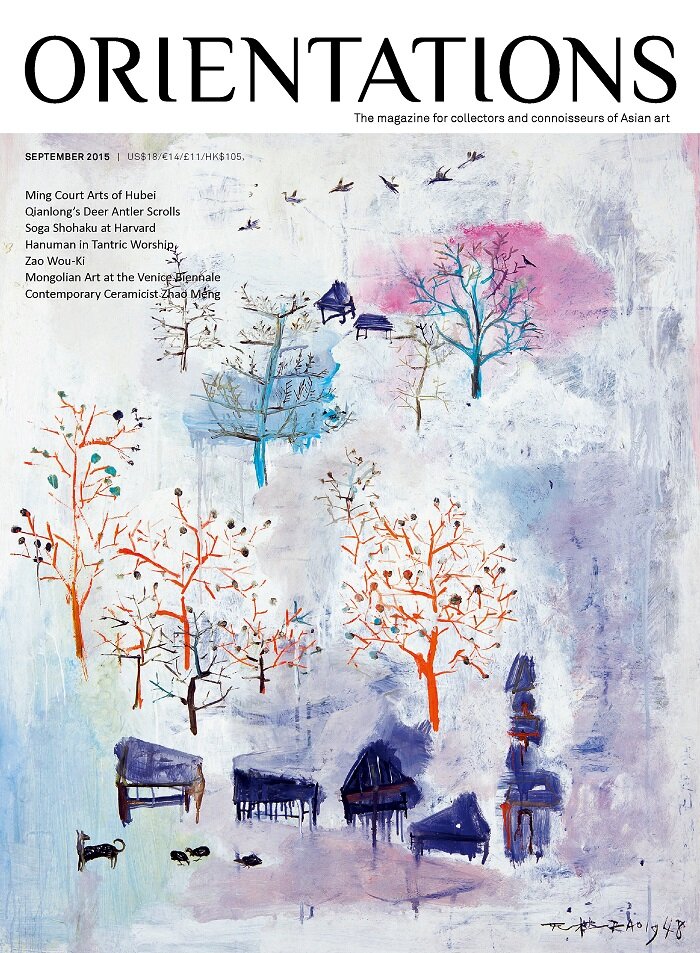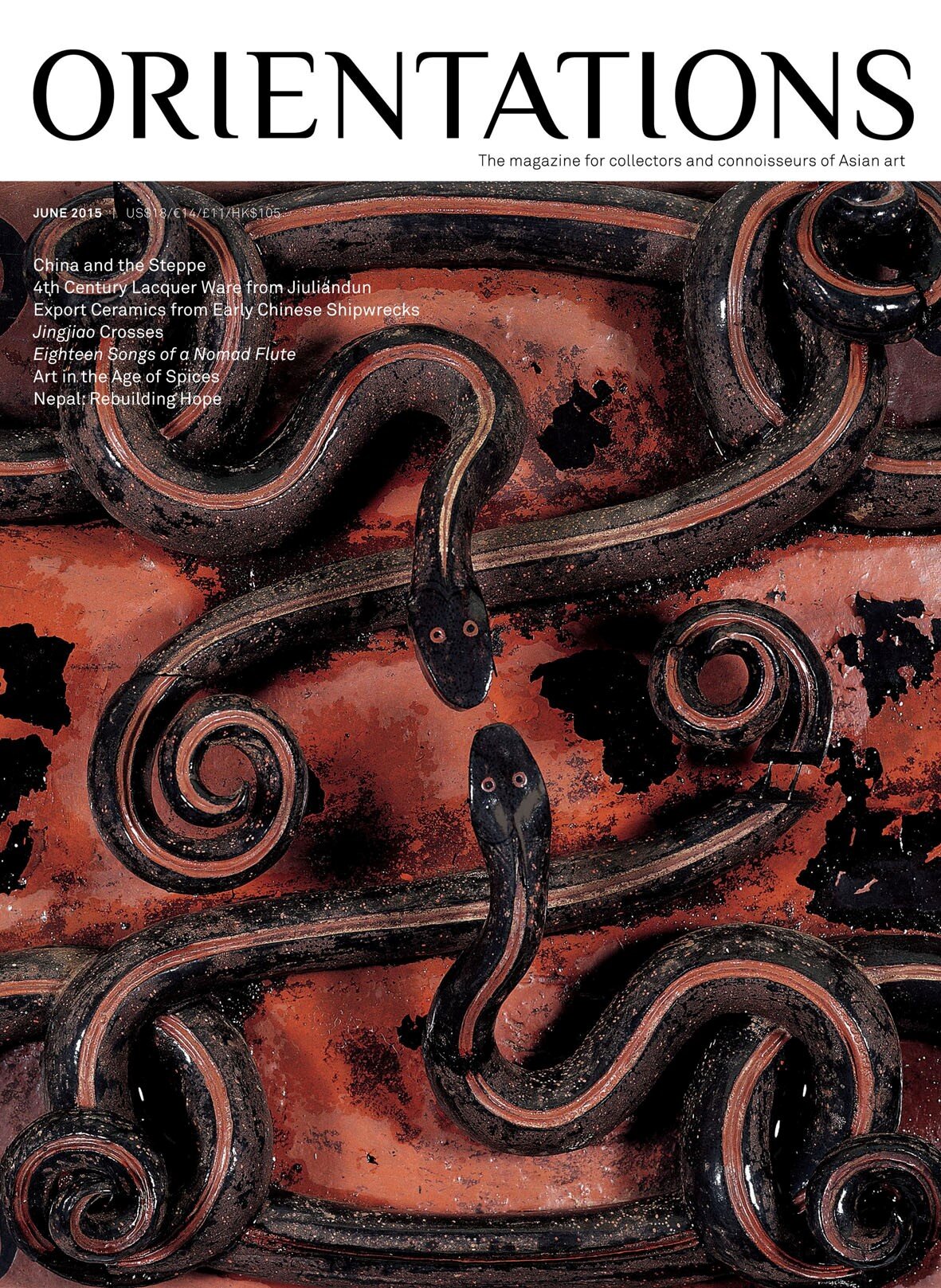NOV/DEC 2015
VOLUME 46 - NUMBER 8
The starting point for this issue is the theme of faking in Chinese ceramics. Four authors offer different responses to the topic, showing that studies of fakes can contribute to our understanding of global material culture. Stacey Pierson focuses on a small group of porcelains made in the Qing dynasty, bearing fake reign marks of the Xuanhe period.
Bing Zhao, who provided the inspiration for this issue, explores the faking of Longquan celadon in the early 20th century, along with the globalization of the Chinese antiquities trade. Kobayashi Hitoshi presents approaches towards the evaluation and authentication of antique ceramics in Japan in the early 20th century, a formative period in ceramics research. Nicole T. C. Chiang introduces the study collection at the Museum of East Asian Art in Bath, revealing how Bluett & Sons and Sydney Smith actively acquired and studied fakes as a way of equipping themselves with better knowledge.
A transformative bequest of Japanese art from the Mary and Jackson Burke Foundation is the subject of a major exhibition marking the end of the Asian art department’s centennial celebrations at the Met. In his article, John Carpenter offers a curator’s perspective on some of his favourite works.
Finally, seventy rubbings and epitaph stones from the Bei Shan Tang collection are on view at The Chinese University of Hong Kong this autumn. Peggy Ho provides perspectives on developments in Chinese calligraphy as revealed by some of the highlights of this show.
FEATURES
Stacey Pierson and Bing Zhao. On ‘Fakes’ and Faking in Chinese Ceramics of the 18th-20th Century
Stacey Pierson. Authentic Ceramics with Fake Reign Marks: Characterizing Xuanhe Nian Zhi Wares of the Qing Dynasty
Bing Zhao. Ancient Objects, New World: Fake Celadon Production in Longquan in the Early 20th Century
Kobayashi Hitoshi. Kansho-toki and the Authentication of Early 20th Century Chinese Porcelain in Japan
Nicole T. C. Chiang. ‘Fakes’ as Educational Materials: The Study Collection at the Museum of East Asian Art, Bath
John Carpenter. Strands of Elegance: A Curator’s View of the Mary Griggs Burke Collection of Japanese Art
Peggy Ho. The Bei Shan Tang Legacy: Rubbings of Stone Engraving and Model Calligraphy
PREVIEWS & REVIEWS
Michael Henss. Book Review: The History of Central Asia, Volumes One and Two, by Christoph Baumer
Asian Art in London 2015
NEWS
News
In and Around the Galleries
COMMENTARY
Letter to the Editor
VOLUME 46 - NUMBER 8
The starting point for this issue is the theme of faking in Chinese ceramics. Four authors offer different responses to the topic, showing that studies of fakes can contribute to our understanding of global material culture. Stacey Pierson focuses on a small group of porcelains made in the Qing dynasty, bearing fake reign marks of the Xuanhe period.
Bing Zhao, who provided the inspiration for this issue, explores the faking of Longquan celadon in the early 20th century, along with the globalization of the Chinese antiquities trade. Kobayashi Hitoshi presents approaches towards the evaluation and authentication of antique ceramics in Japan in the early 20th century, a formative period in ceramics research. Nicole T. C. Chiang introduces the study collection at the Museum of East Asian Art in Bath, revealing how Bluett & Sons and Sydney Smith actively acquired and studied fakes as a way of equipping themselves with better knowledge.
A transformative bequest of Japanese art from the Mary and Jackson Burke Foundation is the subject of a major exhibition marking the end of the Asian art department’s centennial celebrations at the Met. In his article, John Carpenter offers a curator’s perspective on some of his favourite works.
Finally, seventy rubbings and epitaph stones from the Bei Shan Tang collection are on view at The Chinese University of Hong Kong this autumn. Peggy Ho provides perspectives on developments in Chinese calligraphy as revealed by some of the highlights of this show.
FEATURES
Stacey Pierson and Bing Zhao. On ‘Fakes’ and Faking in Chinese Ceramics of the 18th-20th Century
Stacey Pierson. Authentic Ceramics with Fake Reign Marks: Characterizing Xuanhe Nian Zhi Wares of the Qing Dynasty
Bing Zhao. Ancient Objects, New World: Fake Celadon Production in Longquan in the Early 20th Century
Kobayashi Hitoshi. Kansho-toki and the Authentication of Early 20th Century Chinese Porcelain in Japan
Nicole T. C. Chiang. ‘Fakes’ as Educational Materials: The Study Collection at the Museum of East Asian Art, Bath
John Carpenter. Strands of Elegance: A Curator’s View of the Mary Griggs Burke Collection of Japanese Art
Peggy Ho. The Bei Shan Tang Legacy: Rubbings of Stone Engraving and Model Calligraphy
PREVIEWS & REVIEWS
Michael Henss. Book Review: The History of Central Asia, Volumes One and Two, by Christoph Baumer
Asian Art in London 2015
NEWS
News
In and Around the Galleries
COMMENTARY
Letter to the Editor
VOLUME 46 - NUMBER 8
The starting point for this issue is the theme of faking in Chinese ceramics. Four authors offer different responses to the topic, showing that studies of fakes can contribute to our understanding of global material culture. Stacey Pierson focuses on a small group of porcelains made in the Qing dynasty, bearing fake reign marks of the Xuanhe period.
Bing Zhao, who provided the inspiration for this issue, explores the faking of Longquan celadon in the early 20th century, along with the globalization of the Chinese antiquities trade. Kobayashi Hitoshi presents approaches towards the evaluation and authentication of antique ceramics in Japan in the early 20th century, a formative period in ceramics research. Nicole T. C. Chiang introduces the study collection at the Museum of East Asian Art in Bath, revealing how Bluett & Sons and Sydney Smith actively acquired and studied fakes as a way of equipping themselves with better knowledge.
A transformative bequest of Japanese art from the Mary and Jackson Burke Foundation is the subject of a major exhibition marking the end of the Asian art department’s centennial celebrations at the Met. In his article, John Carpenter offers a curator’s perspective on some of his favourite works.
Finally, seventy rubbings and epitaph stones from the Bei Shan Tang collection are on view at The Chinese University of Hong Kong this autumn. Peggy Ho provides perspectives on developments in Chinese calligraphy as revealed by some of the highlights of this show.
FEATURES
Stacey Pierson and Bing Zhao. On ‘Fakes’ and Faking in Chinese Ceramics of the 18th-20th Century
Stacey Pierson. Authentic Ceramics with Fake Reign Marks: Characterizing Xuanhe Nian Zhi Wares of the Qing Dynasty
Bing Zhao. Ancient Objects, New World: Fake Celadon Production in Longquan in the Early 20th Century
Kobayashi Hitoshi. Kansho-toki and the Authentication of Early 20th Century Chinese Porcelain in Japan
Nicole T. C. Chiang. ‘Fakes’ as Educational Materials: The Study Collection at the Museum of East Asian Art, Bath
John Carpenter. Strands of Elegance: A Curator’s View of the Mary Griggs Burke Collection of Japanese Art
Peggy Ho. The Bei Shan Tang Legacy: Rubbings of Stone Engraving and Model Calligraphy
PREVIEWS & REVIEWS
Michael Henss. Book Review: The History of Central Asia, Volumes One and Two, by Christoph Baumer
Asian Art in London 2015
NEWS
News
In and Around the Galleries
COMMENTARY
Letter to the Editor






